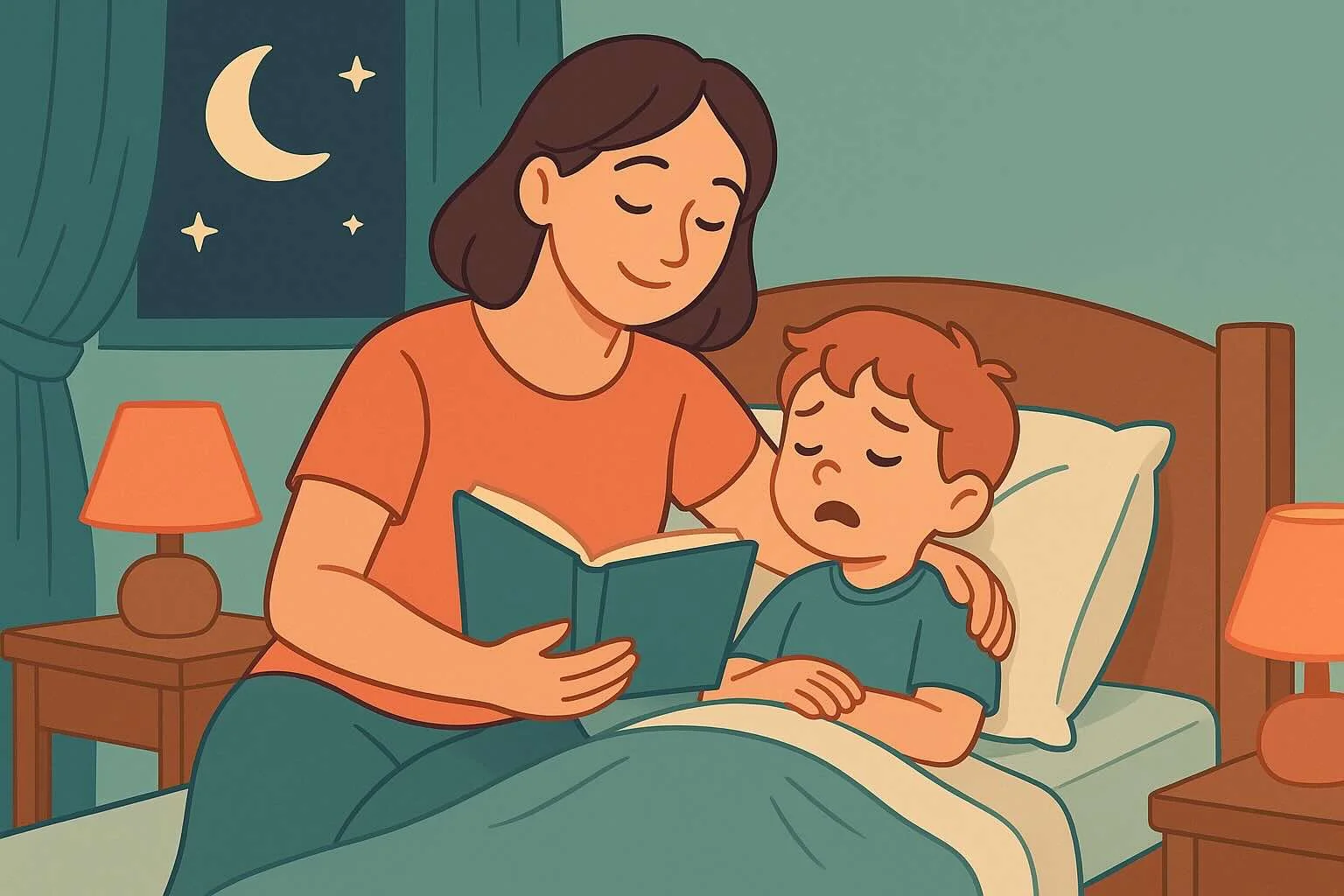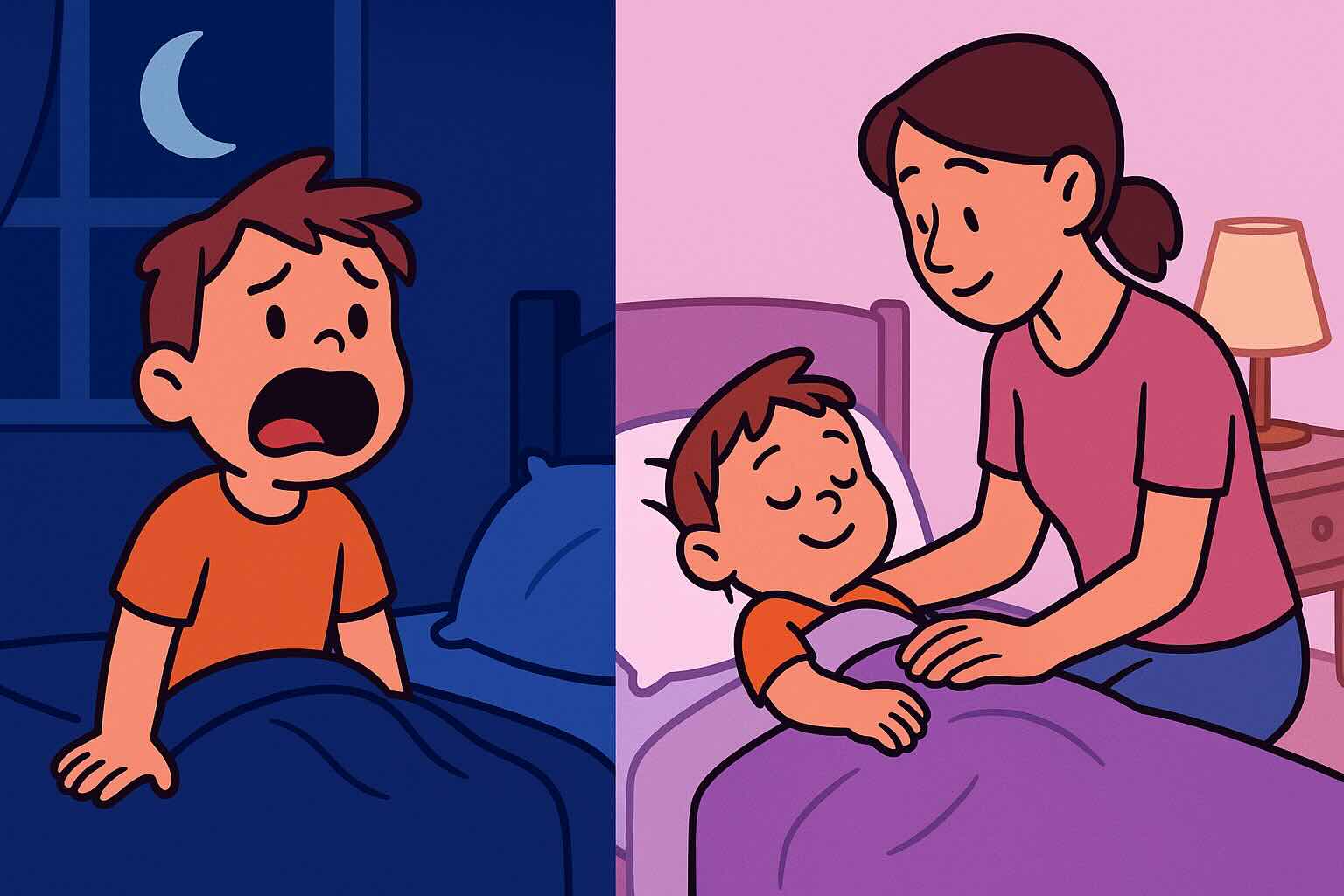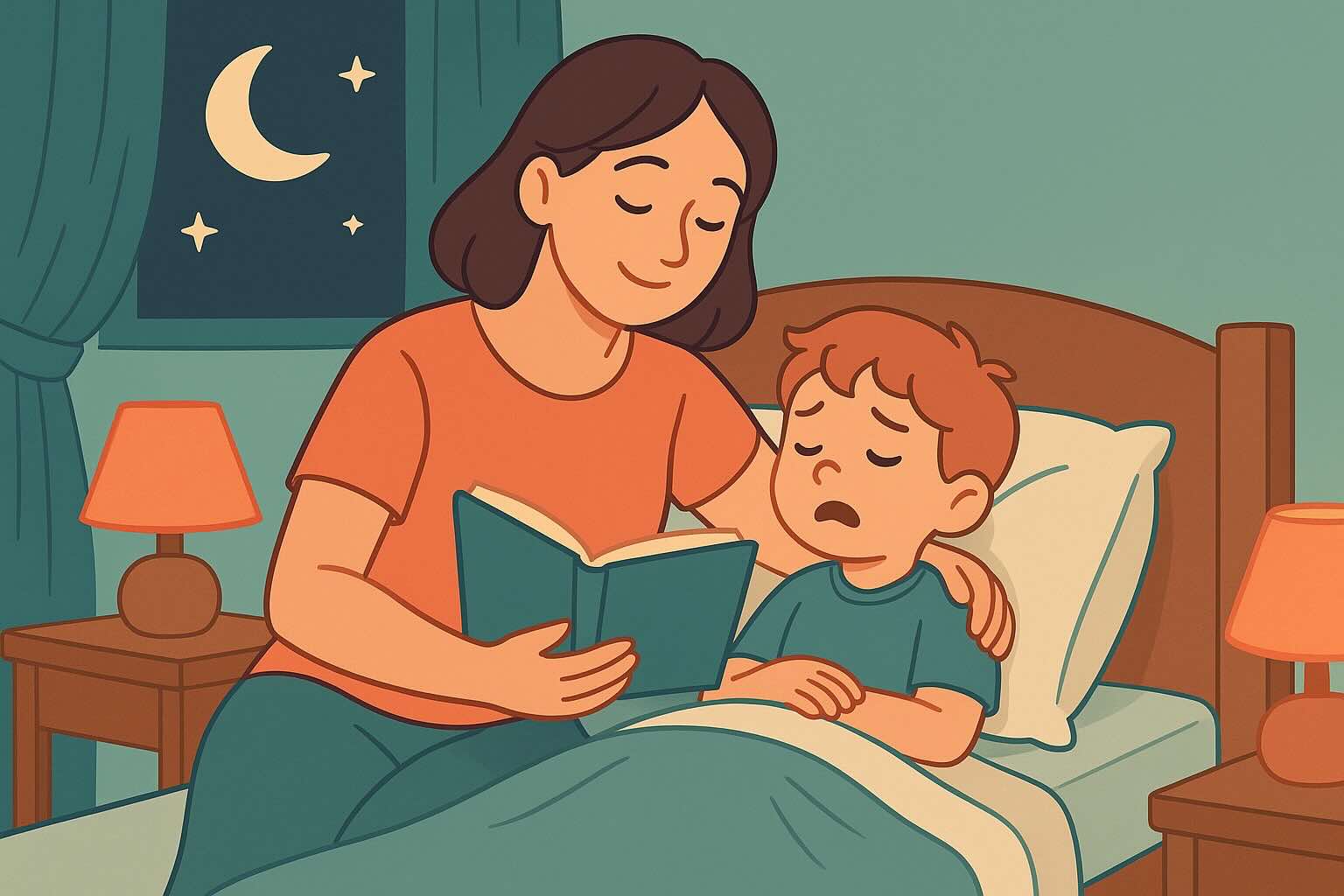Transitioning to Independent Sleep: Complete Guide for Ages 3-7

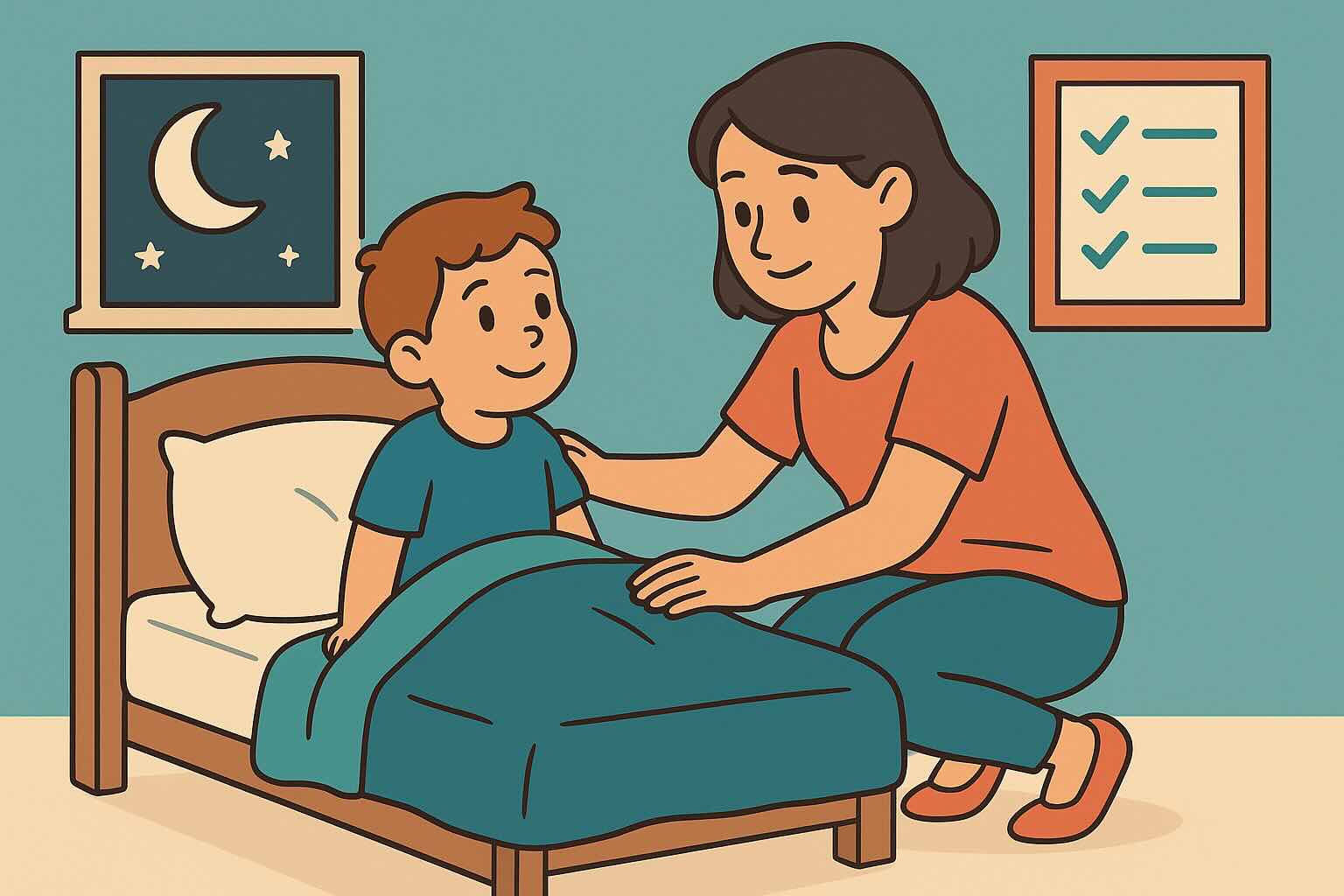
If you've been co-sleeping or staying with your child until they fall asleep and you're ready for change, you're embarking on one of parenting's most challenging yet rewarding transitions. Research shows that 40% of families with children ages 3-7 struggle with sleep independence, but with the right approach, 85% successfully make the transition within 4-6 weeks.
This comprehensive guide provides a proven framework for moving from dependent sleep arrangements to independent sleep skills, whether you're transitioning from co-sleeping, breaking the habit of lying with your child, or helping them stay in their own room throughout the night.
What You'll Learn in This Guide
- When and Why to Transition - Optimal timing and readiness indicators for your family
- The 2-Stage Method - A proven gradual approach that reduces emotional intensity
- Preparation Strategies - How to set up your child and environment for success
- Handling Resistance - Scripts and strategies for common challenges
- Middle-of-Night Solutions - Preventing room visits and early morning wake-ups
- Special Circumstances - Approaches for anxious children, siblings, and unique situations
- Maintaining Independence - Preventing regression and building long-term success
For additional sleep support, see our guides on stopping bedtime battles, overcoming bedtime fears, building healthy sleep habits, and solving night wakings. If your child experiences intense nighttime fears during the transition, our comprehensive nighttime fears guide provides the CALM method and age-specific courage-building strategies.
Estimated reading time: 13 minutes
Understanding Sleep Independence: What It Means and Why It Matters
Defining Independent Sleep
Independent sleep means your child can:
- Fall asleep in their own bed without your physical presence
- Stay in their bed throughout the night
- Return to sleep after normal night wakings without calling for you
- Handle brief awakenings or environmental changes independently
Independent sleep does NOT require:
- Sleeping without comfort objects
- Never needing comfort during illness or unusual stress
- Perfect sleep with zero night wakings
- Complete emotional regulation without any support
Why Families Choose to Transition
Common motivations include:
- Parental sleep quality: Co-sleeping or bedtime presence often disrupts adult sleep
- Relationship impacts: Partners need private time and space
- Practical considerations: Pregnancy, work schedules, or living arrangements
- Child development: Supporting independence and self-reliance skills
- Future preparation: Siblings, sleepovers, or travel considerations
Important note: There's no single "right" approach to family sleep arrangements. Some families successfully co-sleep long-term. This guide is for families who have decided independent sleep is their goal.
Developmental Readiness Indicators
Ages 3-4 readiness signs:
- Can communicate basic needs and feelings verbally
- Shows independence in other areas (playing alone briefly, using bathroom)
- Understands cause-and-effect relationships
- Can follow 2-3 step directions consistently
Ages 5-7 readiness signs:
- Demonstrates self-control in other situations
- Can problem-solve simple challenges independently
- Shows pride in accomplishments and "big kid" status
- Understands time concepts (tomorrow, later, etc.)
The 2-Stage Transition Method
This gradual approach reduces emotional intensity while building necessary skills systematically. Research shows significantly higher success rates compared to immediate transitions.
Stage 1: Own Room with Your Presence (Week 1)
Goal: Help your child become comfortable in their sleep environment while maintaining the security of your presence.
Setup:
- Child sleeps in their own bed/room
- You remain present during sleep onset
- Gradually reduce interaction while maintaining presence
- Duration: 3-7 days typically
Your role during Stage 1:
- Provide calm, quiet presence without extensive interaction
- Respond to requests minimally ("Time to sleep" or "Shhh")
- Avoid stimulating activities (talking, playing, extensive comfort)
- Stay until child is asleep initially, then begin leaving slightly earlier each night
What this teaches:
- Their bed and room are safe, comfortable spaces
- They can fall asleep without being in your bed or room
- Sleep happens through their own body's processes, not your actions
- Comfort can come from environment and self-soothing, not just parent presence
Stage 2: Independent Sleep Onset (Weeks 2-4)
Goal: Transition to your child falling asleep without your physical presence while building confidence in their ability to self-soothe.
Gradual withdrawal options:
Option A: Distance Reduction
- Night 1-2: Sit next to bed
- Night 3-4: Sit across room
- Night 5-6: Sit in doorway
- Night 7+: Leave after brief goodnight
Option B: Time Reduction
- Night 1-2: Stay 15 minutes
- Night 3-4: Stay 10 minutes
- Night 5-6: Stay 5 minutes
- Night 7+: Leave after goodnight routine
Option C: Check-in Method
- Leave after goodnight routine
- Return for brief check-ins if needed (5, 10, 15-minute intervals)
- Keep check-ins brief and calm ("You're okay, time to sleep")
Preparation: Setting Up for Success
Creating the Sleep Story
Before beginning the transition, create a clear narrative that helps your child understand and participate in the process.
Sample sleep story script: "We've been sleeping together, and it's been cozy and nice. Now you're getting bigger and stronger, and we're going to practice sleeping in your own space. This is what we're going to do..."
Include in your story:
- Why you're making this change (positive framing)
- Exactly what will happen each night
- How you'll respond if they need comfort
- What they can do to help themselves
- Timeline expectations ("We'll practice this for a few weeks")
Share your story:
- During calm, connected moments (not at bedtime)
- Multiple times over 2-3 days before starting
- Include them in planning when possible
- Role-play with dolls or stuffed animals
Environmental Preparation
Physical space setup:
- Ensure their room feels safe and comfortable
- Address any legitimate concerns (temperature, noise, lighting)
- Provide appropriate comfort objects
- Remove overstimulating items
- Consider small nightlight if needed
Comfort object strategy:
- Let child choose their special sleep companion
- "Charge" the object with love and comfort during daytime
- Practice using it for comfort during non-sleep times
- Make it part of the bedtime routine consistently
Family Logistics
Timing considerations:
- Avoid starting during stressful periods (illness, travel, major changes)
- Ensure both parents are committed to the plan
- Plan for potential sleep disruption during transition
- Consider impact on other family members
Partner coordination:
- Agree on specific strategies and responses
- Designate primary transition leader if helpful
- Plan support for the leading parent
- Discuss how to handle disagreements during process
Handling Common Resistance Patterns
"I Need You to Stay!"
Validation + boundary script: "You want me to stay because that feels safe and cozy. I understand that. AND now it's time to practice sleeping on your own. You can do this."
Follow-up responses:
- "I believe you can do this."
- "Your [comfort object] will stay with you all night."
- "I'll be nearby, and you can think about me while you fall asleep."
What NOT to say:
- "Don't be scared" (dismisses feelings)
- "I'll stay just for tonight" (creates false expectations)
- "Big kids don't need mommy" (shame-based motivation)
Middle-of-the-Night Room Visits
Consistent response protocol:
- Stay calm: Don't engage in conversations or negotiations
- Brief response: "Back to your bed, time to sleep"
- Physical guidance: Walk them back if necessary
- Minimal interaction: No extended comfort or discussion
- Repeat as needed: Consistency is more important than perfection
Environmental supports:
- Gate at doorway as visual boundary (if age-appropriate)
- Nightlight for safe navigation
- Comfort items in their bed ready for return
- White noise to mask household sounds
"I Can't Fall Asleep Without You!"
Teaching self-soothing skills: "Your body knows how to fall asleep. Let's practice the things you can do to help yourself feel sleepy and calm."
Specific skills to teach:
- Deep breathing: "Breathe in through your nose, out through your mouth slowly"
- Progressive relaxation: "Make your body loose and floppy like spaghetti"
- Positive imagery: "Think about your favorite peaceful place"
- Self-talk: "I am safe, I am loved, I can sleep"
Extended Crying or Distress
Supporting without reinforcing dependence:
- Validate emotions: "This is hard for you"
- Remind of capability: "You can do hard things"
- Offer coping tools: "What could help you feel better?"
- Maintain boundary: "AND sleeping in your own bed is what we're practicing"
When to provide additional comfort:
- Illness or unusual stress
- Genuine fear vs. testing boundaries
- Extreme distress beyond typical protest
- Safety concerns
How to provide comfort without derailing progress:
- Brief visit with minimal interaction
- Verbal reassurance from doorway
- Offer comfort object or environmental adjustment
- Return to plan once comfort is provided
Age-Specific Transition Strategies
Ages 3-4: Concrete Support and Routine
Developmental considerations:
- Need concrete explanations and visual supports
- Strong attachment to routines and familiar objects
- Limited understanding of abstract time concepts
- High need for emotional comfort and validation
Effective strategies:
- Visual charts showing bedtime routine and expectations
- Special "big kid" language and celebrations
- Comfort objects with assigned "jobs" (keeping child safe, providing hugs)
- Simple cause-and-effect explanations
Sample scripts:
- "Big kids sleep in their own beds, and you're a big kid now!"
- "Your teddy bear has the important job of keeping you company while you sleep."
- "When you sleep in your own bed, you grow strong and smart."
Ages 5-7: Logic and Independence Building
Developmental considerations:
- Can understand more complex explanations and reasoning
- Developing sense of pride in independence and capability
- May have stronger willpower and negotiation skills
- Beginning to understand family needs beyond their own
Effective strategies:
- Involve them in creating the transition plan
- Appeal to their desire for independence and maturity
- Use problem-solving approach for challenges
- Create systems for tracking progress and celebrating success
Sample scripts:
- "Let's figure out together how to make your room the perfect place for you to sleep."
- "What ideas do you have for helping yourself feel brave at bedtime?"
- "Sleeping independently is an important skill that will help you your whole life."
Special Circumstances and Adaptations
Anxious or Highly Sensitive Children
Modified approach considerations:
- Slower transition timeline (2-3 weeks per stage)
- Additional comfort measures during transition
- Focus on building coping skills before independence
- Professional support if anxiety is severe
Specific strategies:
- Gradual exposure to sleeping alone (start with naps)
- Extra emphasis on self-soothing skill development
- Detailed preparation and predictability
- Celebration of small steps and partial successes
Siblings Sharing Rooms
Coordination strategies:
- Staggered bedtimes to reduce disruption
- Clear expectations for non-transitioning sibling
- Backup sleep location if disruption is significant
- Family meeting to explain situation and get cooperation
Managing different needs:
- Noise-canceling or white noise solutions
- Visual barriers (curtains, screens) if helpful
- Different comfort items for each child
- Individual attention for the non-transitioning child
Single Parent Considerations
Support strategies:
- Build in extra recovery time during transition
- Arrange backup support for particularly difficult nights
- Prioritize consistency over perfection
- Connect with other single parents for encouragement
Practical adaptations:
- Consider slower transition timeline
- Plan for self-care during stressful transition period
- Celebrate progress and acknowledge difficulty
- Seek professional support if feeling overwhelmed
Maintaining Independence Long-Term
Preventing Regression
Common regression triggers:
- Illness or changes in health
- Family stress or major life changes
- Travel or disrupted routines
- New fears or developmental leaps
Regression response strategies:
- Temporary increased support without reverting to old patterns
- Return to independent sleep expectations as soon as possible
- Address underlying stressors when feasible
- Maintain confidence in child's capabilities
Building Sleep Resilience
Skills that support long-term independence:
- Flexible self-soothing strategies
- Problem-solving abilities for sleep challenges
- Confidence in their sleep environment
- Understanding of sleep's importance for health and growth
Ongoing support approaches:
- Regular check-ins about sleep quality and challenges
- Continued skill-building during calm moments
- Environmental adjustments as child grows
- Celebration of independence and capability
Handling Special Situations
Temporary co-sleeping during:
- Illness with fever or distress
- Family emergencies or unusual circumstances
- Travel with space limitations
- Natural disasters or safety concerns
Returning to independence after exceptions:
- Acknowledge the temporary nature: "Last night was special because you were sick"
- Return to normal expectations as soon as appropriate
- Remind child of their sleep skills and capabilities
- Don't extend exceptions beyond necessary timeframe
Realistic Timeline and Expectations
Week-by-Week Progression
Week 1 (Stage 1): Adjustment
- Expect: Some resistance and testing of new arrangement
- Focus: Consistency with presence while child adjusts to new sleep location
- Progress markers: Child settles more quickly, less protest about location
Week 2 (Early Stage 2): Independence Building
- Expect: Increased resistance as you reduce presence
- Focus: Gradual withdrawal while building coping skills
- Progress markers: Ability to settle with less direct interaction
Week 3-4 (Late Stage 2): Consolidation
- Expect: More consistent independent sleep with occasional setbacks
- Focus: Maintaining boundaries while supporting continued skill development
- Progress markers: Faster sleep onset, fewer middle-of-night visits
Week 5+: Maintenance
- Expect: Generally independent sleep with occasional regression during stress
- Focus: Supporting ongoing independence while addressing challenges
- Progress markers: Confident, consistent independent sleep
Success Indicators
Early success signs (Week 1-2):
- Reduced protest time at bedtime
- Willingness to try new arrangement
- Any evidence of self-soothing attempts
- Improved daytime mood due to better parent rest
Established success signs (Week 3-4):
- Consistent ability to fall asleep independently
- Staying in own bed most nights
- Quick return to sleep after night wakings
- Pride in their independence
Long-term success indicators:
- Independent sleep during various circumstances
- Ability to handle sleep challenges with coping skills
- Positive associations with their sleep environment
- Family satisfaction with sleep arrangements
Troubleshooting Common Challenges
"Nothing Is Working!"
Assessment questions:
- Are both parents responding consistently?
- Is the timeline realistic for your child's temperament?
- Are there underlying stressors affecting the family?
- Is the approach developmentally appropriate?
Potential modifications:
- Slow down the transition timeline
- Increase comfort measures temporarily
- Address environmental factors
- Consider professional consultation
Extended Night Crying
Response strategies:
- Brief check-ins without engaging in extended interaction
- Validation without changing expectations
- Ensure basic needs are met (temperature, bathroom, water)
- Maintain calm confidence in child's abilities
If sleep training methods could complement your transition approach, our evidence-based sleep training guide provides information about various techniques and their effectiveness for different family situations.
When to be concerned:
- Crying lasting over 45 minutes nightly for more than a week
- Signs of panic or extreme distress
- Daytime behavioral changes suggesting trauma
- Physical symptoms related to sleep stress
Partner Disagreement During Process
Resolution approaches:
- Pause transition to resolve disagreements
- Seek compromise on timeline or specific strategies
- Consider one parent leading while other supports
- Professional guidance if disagreements persist
Professional Support: When and How
Indicators for Professional Help
Consider consultation for:
- Severe anxiety or panic during transition attempts
- History of trauma affecting sleep associations
- Special needs requiring modified approaches
- Family stress significantly impacting daily functioning
- Persistent sleep difficulties beyond 6-8 weeks
Types of Professional Support
Pediatric sleep specialists can help with:
- Medical evaluation of sleep difficulties
- Customized sleep plans for complex situations
- Assessment of underlying sleep disorders
- Coordination with other healthcare providers
Child psychologists specializing in sleep can provide:
- Anxiety treatment affecting sleep independence
- Family therapy for sleep-related conflicts
- Behavioral interventions for resistance patterns
- Support for trauma-related sleep challenges
Certified sleep consultants offer:
- Detailed sleep plan development
- Ongoing support during implementation
- Troubleshooting for specific challenges
- Family education about healthy sleep habits
Real Parent Success Stories
Maria's Story: Co-Sleeping Transition at Age 4
"Sofia had been sleeping in our bed since she was born. At 4, we were all sleeping poorly and my husband and I had no couple time. We started with the 2-stage method. Stage 1 was easier than expected—she loved having her 'big girl room' set up specially for her. Stage 2 was harder. She cried for about 20 minutes the first few nights, but I stayed calm and reminded her she could do it. After 3 weeks, she was sleeping independently and actually seemed more rested. The key was staying consistent even when it was hard."
David's Story: Breaking the Lying Down Habit at Age 6
"I had been lying down with my son Jake every night for 2 years. It started when he was scared, but became a habit that took 45 minutes every night. I used the gradual distance method—first sitting next to his bed, then by the door, then leaving after 5 minutes. He protested each change, but I reminded him he was growing up and could do this. It took about a month, but now he's proud of sleeping on his own and I have my evenings back."
Sarah's Story: Room Visits Solution at Age 5
"Emma would go to sleep fine but come to our room 2-3 times every night. I started walking her back every single time with the same phrase: 'Back to your bed, time to sleep.' No discussions, no negotiations. The first week was exhausting—I walked her back 15 times one night! But by week 2, it dropped to once a night, and by week 3, she was staying in her room. Consistency was everything."
Jennifer's Story: Anxious Child Gradual Transition at Age 7
"My daughter has always been anxious and the thought of sleeping alone terrified her. We went very slowly—first she slept in her room with me on a mattress on the floor for 2 weeks. Then I gradually moved the mattress farther away. We also worked on 'brave thoughts' and breathing exercises during the day. It took 8 weeks total, but she got there and feels so proud of herself now."
Your 6-Week Transition Plan
Week 1: Preparation and Stage 1 Setup
- Days 1-2: Create and share your sleep story with your child
- Days 3-4: Set up their sleep environment and practice bedtime routine in new space
- Days 5-7: Begin Stage 1 - child sleeps in their own bed/room with your presence
- Focus: Establishing comfort with new sleep location
Week 2: Stage 1 Refinement and Stage 2 Preparation
- Days 1-3: Continue Stage 1 while gradually reducing interaction
- Days 4-5: Prepare child for Stage 2 transition
- Days 6-7: Begin Stage 2 - gradual reduction of your presence
- Focus: Building confidence in their ability to sleep in their own space
Week 3: Stage 2 Implementation
- Days 1-7: Continue gradual withdrawal of presence
- Adjust timeline based on child's response
- Focus: Supporting independent sleep onset while maintaining emotional connection
Week 4: Independence Building
- Days 1-7: Child falling asleep independently most nights
- Address any remaining middle-of-night visits
- Focus: Consolidating new sleep patterns and celebrating progress
Week 5: Troubleshooting and Refinement
- Days 1-7: Fine-tune any remaining challenges
- Build additional coping skills as needed
- Focus: Ensuring sustainable independent sleep patterns
Week 6: Establishment and Future Planning
- Days 1-7: Celebrate successful independent sleep
- Plan for maintaining progress during challenges
- Focus: Long-term success strategies and family satisfaction
Key Takeaways: Your Independent Sleep Success Guide
- ✅ The 2-stage gradual method has 85% success rate and reduces emotional intensity
- ✅ Preparation and planning are more important than perfect execution
- ✅ Consistency across caregivers is crucial for faster progress
- ✅ Some resistance is normal and doesn't indicate failure or harm
- ✅ Age-appropriate strategies improve cooperation and success rates
- ✅ Environmental support can ease transition without creating dependence
- ✅ Timeline flexibility accommodates individual differences and family needs
- ✅ Professional support is available for complex situations or persistent challenges
Remember: Teaching your child to sleep independently is a gift that lasts a lifetime. You're not just improving your family's sleep—you're building your child's confidence, self-reliance, and emotional regulation skills. Every night they successfully sleep on their own, they're proving to themselves that they can handle challenges and grow stronger.
Once your child is sleeping independently in their own room, our night wakings solutions guide can help address any remaining brief awakenings, building on the self-soothing skills developed during the transition process.
This article is based on current pediatric sleep research and child development science. Individual families may need modified approaches based on specific circumstances, child temperament, and family dynamics. Consult with qualified professionals if you have concerns about your child's sleep patterns or emotional wellbeing during transitions.
24/7 AI Parenting Assistant
Get instant, personalized advice with expert-curated parenting knowledge. Chat with your AI coach anytime, anywhere.
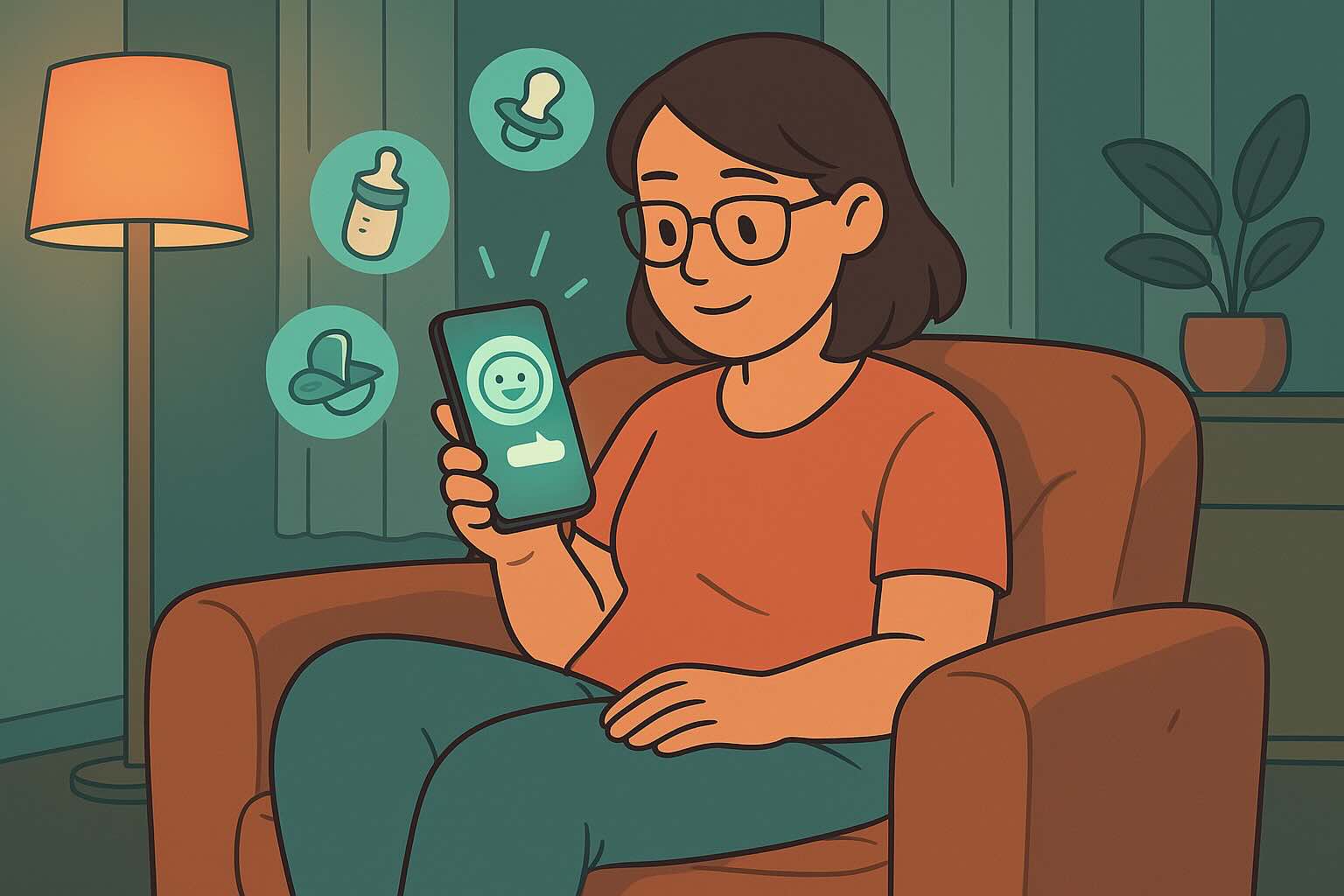
Get Your Free Sleep Training Toolkit
5-day email course + printable sleep log to help your baby sleep through the night
Frequently Asked Questions
Need personalized support?
RootWise's AI coach can provide tailored strategies for your specific situation, available 24/7 when you need it most.
Learn More About AI Coaching →